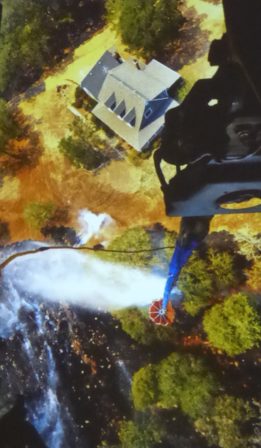Reducing the Risk of Wildfires*

Wilderness abutting communities need to be more carefully regulated.
Last January Gary Ferguson spoke of some of the results of wild fires. He covered aspects of its benefits and those of its dangers. We know that today wildfires occur with increasing frequency; they burn hotter and faster; and they are incredibly difficult to contain. The consequences of wild fires are ecologically and economically enormous. In 2002 a wildfire in Colorado burned 138,000 acres. The losses of property, income, and forest, as well as the cost of extinguishing this fire, came to three billion dollars. State government costs for suppressing wildfires have doubled. According to Ferguson, it would be more economical to spend some of these funds toward prevention. He says, “The Forest Service spends about five hundred times more on putting out fires in the wildland-urban interface (WUI), than it does on preventing them in the first place.”
One issue is that firefighting funds come from the same source that Congress appropriates for research. We are losing staff for research and development in order to deal with the results of these fires. We need to protect our forests as they give us half of our country’s water and “sequester about 13 percent of total U.S. fossil fuel carbon emissions.” If the forests are not protected, they will “become net carbon emitters later this century,” says Ferguson quoting Christopher Topik of The Nature Conservancy.
Ferguson says we need to deal with three goals: first, improve firefighters’ response ability as wildfire emergencies increase; second, we need to “restore fire-adapted landscapes (in other words, undoing some of the damaged caused by eighty years of aggressive fire suppression).” Finally, we need to change the wilderness-urban communities into fire-adapted communities
Improving firefighters’ response is helped by improved communication. Communication is improved when the speakers are familiar with each other. Because each group of firefighters operates somewhat differently, assumptions are made without actual knowledge of how that group functions. One idea to improve communication is for various groups to have more social and professional interactions, thus fostering familiarity with different communication styles. Common radio frequencies can provide access to information about emergencies at various stations would allow the fire fighters to help each other more effectively.
Restoring fire-adapted landscape is another way of dealing with wildfires. The eighty years’ suppression of forest fires has resulted in an excess of fuel in our forests. Downed timber, crowded forests, sick and dry trees, low branches and invading species of flora not adapted to wildfires make fires not only more likely to occur, but these conditions make the fires burn hotter and faster than they do in forests in which fires used to occur naturally. Thinning the forests is expensive, but it allows more rain and more sunshine to fall on the forest floor helping the trees to become healthier and more resistant to diseases. It also means the trees have less competition for water. Due to the exorbitant cost to treat all the forests that need thinning, thinning will need to be done first in areas of the highest risk.
Setting prescribed burns is another treatment method. Dry fuels lining the forests’ floors can be cleared more quickly by setting a controlled fire. However, based on what we need to do to reduce the severity of fires, about 50,000 acres would need to be burned. The public is not happy with the resulting harmful smoke. However, finding an accurate way of predicting winds would enable prescribed burns to be scheduled according to how the weather will disperse and transport the fires’ smoke.
Burning when the weather is cold and wet is counterproductive. The fire-resistant plants’ seeds germinate under hot, dry conditions; moist heat kills most of them. Thus, invading plants take over; these plants typically burn hotter. Herbicides also kill native shrubs leaving a clear field for the fast burning invasive grasses.
Wilderness abutting communities need to be more carefully regulated. New communities should be constructed to meet Fire Protection Association standards. Many of us live in communities that abut wild terrain. Ferguson gave ten ways to protect your home from wild fire.
Immediately next to the structure (zero to five feet) should have only non-combustible materials such as gravel, brick and concrete.
Five to 30 feet should be defensible. Remove dead vegetation, shrubs under trees, and branches that overhang your roof. All sheds and trailers should have the same defensible space.
The property’s siding should be non-combustible. Maintain at least a six-inch clearance between the ground and the building’s siding. Use fire-rated, Class-A roofing.
Clean debris from the top of your roof. Hot embers can ignite debris if blown onto it.
Keep your gutters clean. Any gutter covers should be non-combustible. Use non-combustible materials for fencing, gates, and other decorative structures to reduce the danger of their catching fire.
Keep vents covered with 1/8-inch mesh and close open eaves to protect your attic from burning embers.
Protect your windows. Use multi-paned tempered glass. Close windows if fire is likely.
If you have a wooden deck and/or stairs, use California’s requirements for new construction. Remove combustibles from under decks and stairs.
We need to be mindful of what we are doing to our planet. Pollution, over-crowding of plants and people, changing the landscape are just a few of the many areas we need to examine while keeping in mind that one action may affect a host of other issues.
The next meeting of the Mission Hills Garden Club will be from 6 to 8 p.m., Wednesday, September 26 at Mission Hills Nursery, 1525 Fort Stockton Street. I will give the topic in a future article.
*I am extremely sorry to have just realized that the May article was a repeat. This is the article that was to follow the April article on wildfires. Due to operator (that would be me) error with the computer, I inadvertently erased the May article. Thanks for your understanding.
Category: feature, Local News







